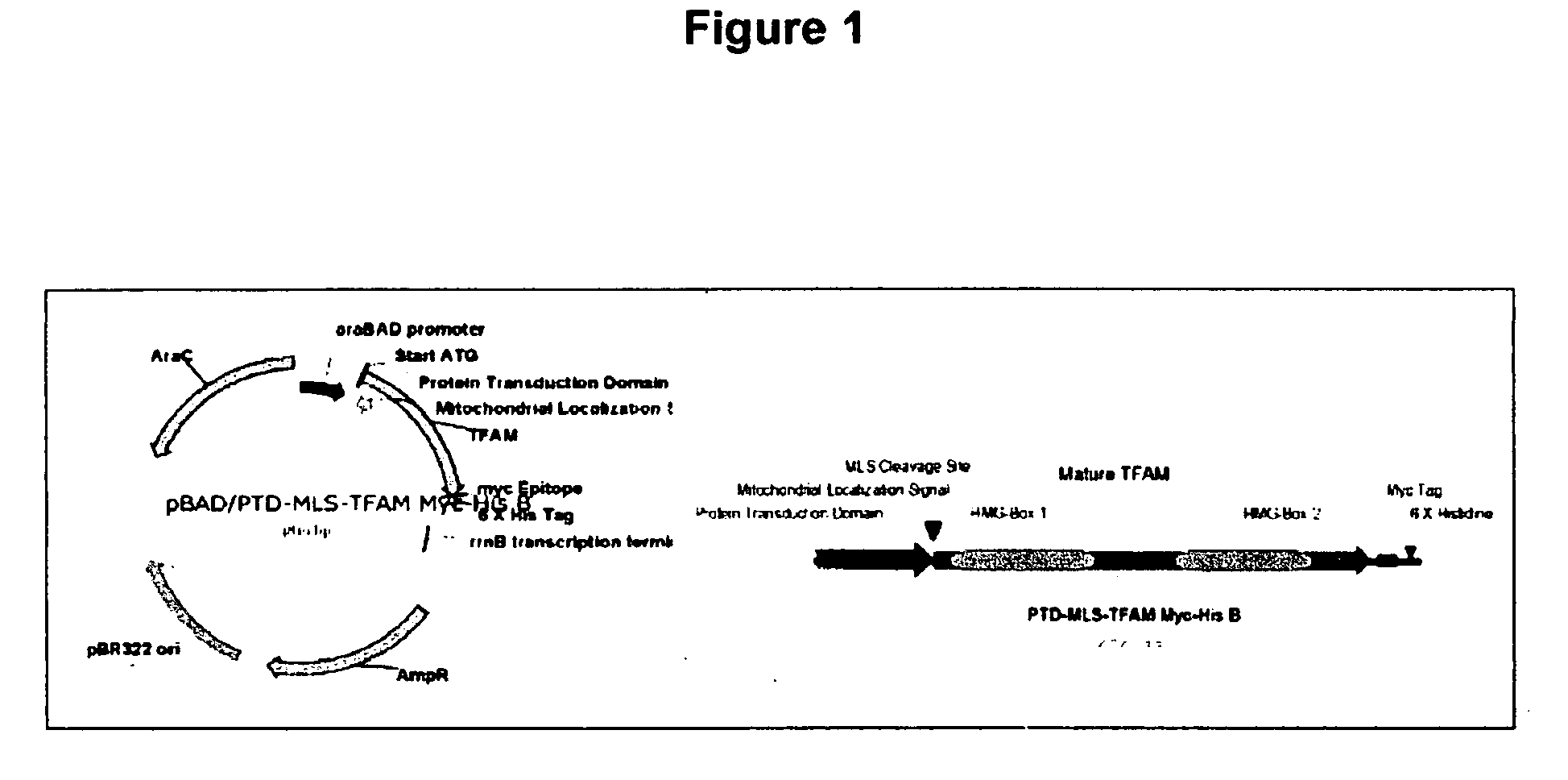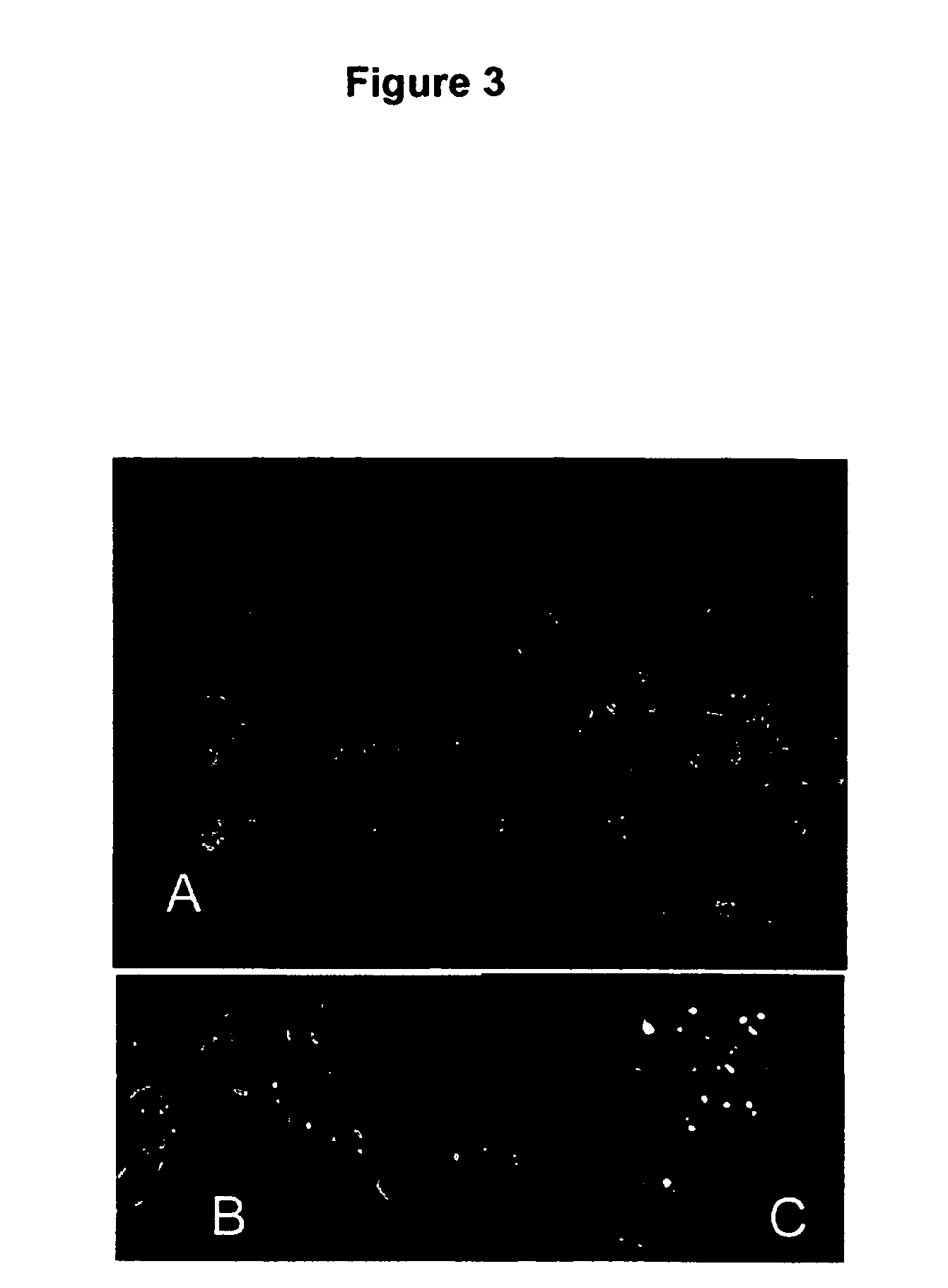Methods and compositions for delivering polynucleotides
a polynucleotide and polypeptide technology, applied in the direction of dna/rna fragmentation, peptide/protein ingredient, depsipeptide, etc., can solve the problems of reducing the effectiveness of gene therapy, manipulating the mitochondrial genome, and hampered understanding of the mtdna genotype-phenotype relationship to develop specific treatment for mtdna-based diseases
- Summary
- Abstract
- Description
- Claims
- Application Information
AI Technical Summary
Benefits of technology
Problems solved by technology
Method used
Image
Examples
example 1
Recombinant Constructs
[0162] The 11 amino acid protein transduction domain (PTD) of the HIV Tat protein was cloned upstream and in frame of the mitochondrial localization signal (MLS) of the human mitochondrial transcription factor A (TFAM). For nuclear transfection, the MLS was replaced with the 9 amino acid nuclear localization signal (NLS) of the SV40 virus T Antigen. The recombinant protein was expressed in bacteria and isolated on a nickel chelating column utilizing a 6× Histidine tag expressed on the C-terminus immediately downstream of an Enterokinase site. The purified protein was incubated with Enterokinase and further purified on a nickel column where the flow-through was collected. The protein was dialyzed overnight at 4° C. against saline containing 33% phospho-buffered saline. Purified protein was concentrated and protein concentration was assessed with the Bradford Assay (Biorad). Purified protein was analyzed with SDS-Page to verify purity.
[0163] Briefly, full-lengt...
example 2
Mitochondrial Expression of GFP
[0164] GFP (Green Fluorescent Protein) cDNA was mutated at the 270 nucleotide position to generate the following codon change (UGG UGA). UGA is read by the mitochondrial translation machinery as a Tryptophan whereas the nuclear translational machinery reads it as a stop codon—producing a non-fluorescing, curtailed GFP when translated by the nuclear machinery but a full-length fluorescent product when translated in the mitochondria. The resultant mitochondrially encoded GFP cDNA was complexed with the PTD-MLS-Tfam as described above and introduced into SY5Y cell culture prestained with MitoTracker Red. The cells were imaged with confocal 24 hours after transfection. GFP signal (green) was observed colocalized with Mitotracker Red (red) producing yellow fluorescence when superimposed (FIGS. 1B and 1C).
[0165] To further verify that the recombinant protein was capable of transfecting cells, Rho cells generated from wild-type mitochondrial genome containi...
example 3
Construct Sequence Data
[0166] TFAM Sequence (Mitochondrial Localization Signal (Underlined) (Locus Link ID: 7019) (SEQ. ID. NO.: 206)
ATGGCGTTTCTCCGAAGCATGTGGGGCGTGCTGAGTGCCCTGGGAAGGGTTTTGTGTATTTACCGAGGTGGTTTTCATCTGTCTTGGCAAGTTGTCCAAAGAAACCTGTAAGTTCTTACCTTCGATTTTCTAAAGAACAACTACCCATATTTAAAGCTCAGAACCCAGATGCAAAAACTACAGAACTAATTAGAAGAATTGCCCAGCGTTGGAGGGAACTTCCTGATTCAAAGAAAAAAATATATCAAGATGCTTATAGGGCGGAGTGGCAGGTATATAAAGAAGAGATAAGCAGATTTAAAGAACAGCTAACTCCAAGTCAGATTATGTCTTTGGAAAAAGAAATCATGGACAAACATTTAAAAAGGAAAGCTATGACAAAAAAAAAAGAGTTAACACTGCTTGGAAAACCAAAAAGACCTCGTTCAGCTTATAACGTTTATGTAGCTGAAAGATTCCAAGAAGCTAAGGGTGATTCACCGCAGGAAAAGCTGAAGACTGTAAAGGAAAACTGGAAAAATCTGTCTGACTCTGAAAAGGAATTATATATTCAGCATGCTAAAGAGGACGAAACTCGTTATCATAATGAAATGAAGTCTTGGGAAGAACAAATGATTGAAGTTGGACGAAAGGATCTTCTACGTCGCACAATAAAGAAACAACGAAAATATGGTGCTGAGGAGTGTTAA
[0167] PTD-MLS-TFAM (PTD Underlined; MLS Double Underline) Sequence (SEQ. ID. NO.: 207):
ATGGCGCGTCGTCGTCGTCGTCGTCGTCGTCGTCGTCGTATGGCGTTTCGAGGTGGTTTTCATCTGTCTTGGCA...
PUM
| Property | Measurement | Unit |
|---|---|---|
| time | aaaaa | aaaaa |
| droplet size | aaaaa | aaaaa |
| physical association | aaaaa | aaaaa |
Abstract
Description
Claims
Application Information
 Login to View More
Login to View More - R&D
- Intellectual Property
- Life Sciences
- Materials
- Tech Scout
- Unparalleled Data Quality
- Higher Quality Content
- 60% Fewer Hallucinations
Browse by: Latest US Patents, China's latest patents, Technical Efficacy Thesaurus, Application Domain, Technology Topic, Popular Technical Reports.
© 2025 PatSnap. All rights reserved.Legal|Privacy policy|Modern Slavery Act Transparency Statement|Sitemap|About US| Contact US: help@patsnap.com



